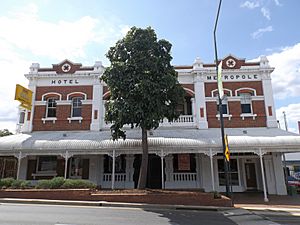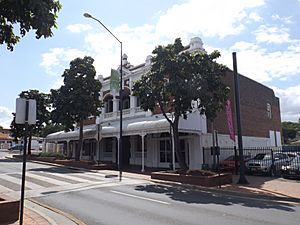Hotel Metropole, Ipswich facts for kids
Quick facts for kids Hotel Metropole |
|
|---|---|

Front of building, 2015
|
|
| Location | 253 Brisbane Street, West Ipswich, City of Ipswich, Queensland, Australia |
| Design period | 1900 - 1914 (early 20th century) |
| Built | 1906 |
| Architect | George Brockwell Gill |
| Architectural style(s) | Federation |
| Official name: Hotel Metropole | |
| Type | state heritage (built) |
| Designated | 21 October 1992 |
| Reference no. | 600567 |
| Significant period | 1900s (fabric) 1906-ongoing (historical use) |
| Significant components | loggia/s, lead light/s, cellar |
| Lua error in Module:Location_map at line 420: attempt to index field 'wikibase' (a nil value). | |
The Hotel Metropole is a historic hotel located at 253 Brisbane Street in West Ipswich, Queensland, Australia. It was designed by a famous architect named George Brockwell Gill and built in 1906. This building is so important that it was added to the Queensland Heritage Register on 21 October 1992.
History of the Hotel Metropole
This two-storey brick hotel was built in 1906. It was designed by George Brockwell Gill, a well-known architect from Ipswich.
In 1915, some of the land around the hotel was taken over by the Queensland Railways Department. Later, in 1925, a brewing company called Perkins and Co. started leasing the hotel. They continued to run it until 1935.
George Brockwell Gill, the architect, designed many important homes and public buildings in Ipswich between the 1880s and 1930s. Some of his other famous works include the Ipswich Girls' Grammar School (1890/91) and the Ipswich Technical College (1901). He moved to Ipswich from London in 1886 and became a very respected architect.
The building has been used as a hotel since it first opened in 1906. It still operates as a hotel and nightclub today. Over the years, its name changed a few times, like "The Harp of Erin" and "The Silver Fern." However, by the mid-2000s, it went back to being called the Hotel Metropole. In 2015, it included a gastropub called Waghorn and a nightclub called Club Metro, but it kept the main Hotel Metropole name.
What the Hotel Metropole Looks Like
The Hotel Metropole is a large, two-storey building with a basement. It stands at the corner of Brisbane and Waghorn Streets in Ipswich. Built in 1906, it is made of red bricks with special patterns and decorations made from different coloured bricks and cement. The top of the building has decorative gables (pointed roof sections) along the Brisbane Street side. These gables hide a hipped roof made of corrugated iron.
The front of the building, facing Brisbane Street, has a balanced design. In the middle, there's a central covered porch area called a loggia on both the ground and first floors. You enter the hotel through the ground floor loggia. This area is highly decorated with painted cement arches, columns, and railings. The floor here is covered with patterned tiles. There are also arched entrances to the bar areas on either side of the loggia. Another entrance is on Waghorn Street, which leads to a modern beer garden.
The ground floor verandah (a covered porch) along Brisbane and Waghorn Streets has wooden posts and a decorative cast iron border. The roof of this verandah was recently replaced with a curved steel roof.
The first floor loggia has arches made of different coloured bricks, along with columns and other cement decorations. The rest of the building's front is decorated with contrasting cement details. The Waghorn Street side also has a first-floor verandah with a railing that has a sunflower pattern.
Inside, the main entrance from the loggia leads to the bars and a staircase to the first floor. The floor here has wooden patterns, and the ceiling is made of pressed metal. The main staircase is made of cedar wood and is very detailed. There's also a beautiful arched window with decorative stained glass.
The main bar area has been changed over time, with some walls removed to create a larger space. However, parts of the original plaster ceilings and decorations remain. A marble fireplace is on the northern wall of this bar. The other bar area has been updated, so not much of its original look is left.
At the back of the building, there's a kitchen, another staircase, and updated bathrooms. This second staircase goes up to the first floor and down to the basement. The basement is used for storage and has a low ceiling.
The upper floor of the hotel mostly keeps its original layout. It has guest rooms and a common room on one side of the staircase. The other side has been changed into a nightclub. The back of the building has single rooms and bathrooms, with wooden walls and ceilings. Many of the wooden features inside, like doors and frames, are still original and appear to be made of cedar.
Why the Hotel Metropole is Important
The Hotel Metropole was added to the Queensland Heritage Register on 21 October 1992 because it meets several important standards:
- Shows Queensland's History: Built in 1906, the Hotel Metropole shows a time when Ipswich was building many new and impressive buildings. Its grand design also highlights how important local hotels were to communities back then.
- A Great Example of its Kind: The Hotel Metropole is a good example of a Federation-style hotel that is still mostly in its original condition. It shows off the beautiful details of its first design.
- Looks Beautiful: The hotel has great architectural and aesthetic value. It's a landmark in the city and adds to the look of Brisbane Street and the town.
- Important to the Community: The Hotel Metropole has a special connection with the people of Ipswich. It has been a place for social gatherings and activities since it opened in 1906.
- Connected to a Famous Architect: It is also important because it is a clear example of the work of George Brockwell Gill. He was the Ipswich architect who designed many significant homes and public buildings in the city.


